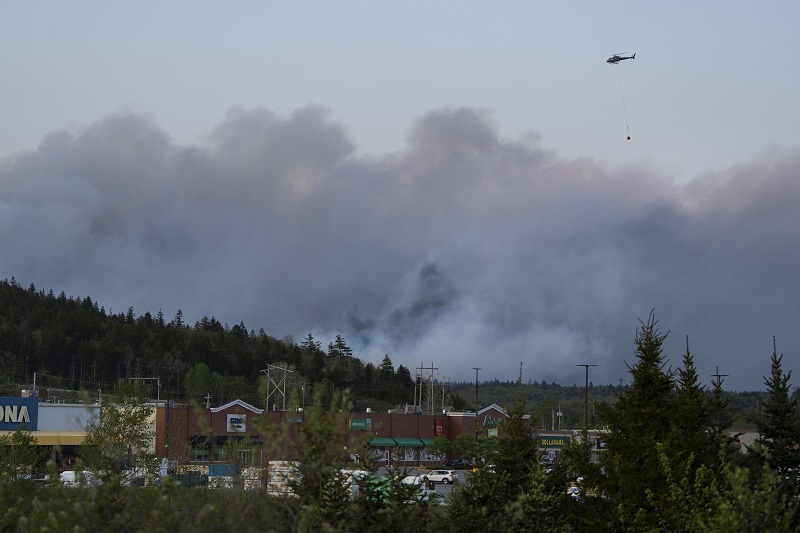What it’s like on the scene of the Nova Scotia wildfires

Two large wildfires burning in Halifax and Shelburne counties in Nova Scotia remain out of control, even as fire and additional living expenses (ALE) claims start to trickle in for insurers and adjusters.
Some adjusters aren’t able to access the scene, and thousands of people remain displaced and uncertain of the status of their properties, industry professionals tell Canadian Underwriter.
“Some people know that their home is a total loss,” Halifax-based Amanda Dean, vice president of Insurance Bureau of Canada’s Atlantic region, said in an interview Thursday. “Some people know their home is still standing, and some people don’t know the status of their home yet. Insurers are hearing questions about ALE… [and what insureds] need to do to get that part started.
“People are in shock,” Dean added. “It’s not something that we’re used to in Nova Scotia,” she said, pointing to the usual rainy springs seen in the province. “We’ve had a very dry spring, which just makes wildfire travel a bit quicker and further. So, this is quite abnormal for us.”
The Halifax-area blaze that began Sunday is still classified as out of control, but is now 50% contained, the city reported Thursday morning. At its peak, 16,492 residents were evacuated, although the evacuation area is starting to reduce.
While damage counts are incomplete, it’s anticipated approximately 150 homes have been destroyed, along with 50 other structures.
In Shelburne County, what’s believed to be the largest fire in the province’s history remains out of control, spread out over about 18,000 hectares. A few thousand people have been displaced.
iStock.com/shaunl
Crawford & Company (Canada) Inc. told CU Wednesday they have “received some direct fire and ALE claims, though not yet a significant number. And we are thankfully in a reasonable position to respond locally,” said Rannoch Harley, Crawford’s director of loss adjusting for Atlantic Canada.
There will also likely be a limit to some early ALE claims, Harley suggested, pointing to the Canadian Red Cross’ announcement of one-time financial assistance of $500 per eligible household for evacuees. “But if civil authority evacuations maintain for days, we’ll start to see more ALE volume start coming in with regularity, in addition to confirmed and prospective direct fire damage claims,” Harley said.
For independent adjusting firm ClaimsPro, its catastrophe team remains on standby, as not a lot of property losses can be assessed at this time. Once the fires subside, adjusters will “have a more accurate idea of what we are dealing with in the way of loss,” said Michael Connolly, vice president of Atlantic Canada for ClaimsPro.
“Unlike Hurricane Fiona, we are unable to spring into action and start helping people onsite at their property because of the nature of this event,” he added. “Our local teams are currently assisting people with accommodations as best we can while we wait. Accommodation options and resources are extremely limited in the city due to the number of people displaced.”
Bumpy roads ahead
Relocating thousands of people while the province was already facing a bit of a housing crisis means some bumpy roads ahead, said Dean. “It’s going to be quite some time getting put back together…but the insurance industry is here on the ground and it’s certainly been noticed.”
Besides ALE questions, insurers are also receiving questions about what the claims process looks like, next steps and what insurance covers, Dean reported. “As people know more about the state of their particular home, we’re expecting that those questions and conversations become a bit more pointed.”
It’s still too early to determine if the fires have reached the threshold of a Cat (more than $30 million in insured damages) but all indications are pointing in that direction.
“Every so often, we see fire outside of Halifax, so that’s nothing new,” Glenn McGillivray managing director of the Institute for Catastrophic Loss Reduction, told CU the day after the Halifax fire started. “But we don’t often see really aggressive fires in the area like this one.”
Dean agreed. “We’re used to hurricanes and wind damage in our region and hearing about wildfires happening out west,” she said. “So, this is a bit of a shock to everyone.
“We have had fires before in communities that have been able to be contained within a number of days. Having this large fire impacting such a densely populated area is certainly a unique event for us.”
Feature image: A helicopter carrying water flies over heavy smoke from an out-of-control fire in a suburban community outside of Halifax that spread quickly, engulfing multiple homes and forcing the evacuation of local residents on Sunday May 28, 2023. THE CANADIAN PRESS/Darren Calabrese







